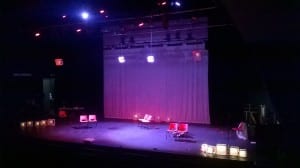So today was the day, the opportunity to finally put together the rest of our piece. Our lighting and sound designers have been working so hard, having only 24hours to put together our tech documents, so it was amazing to see their ideas come to life of stage!
Two weeks before our tech, our ASM organised a session with the LPAC stage manager, Darren, for us to try out a few ideas before making our final decisions for tech. We asked the team to provide us with 2 microphones, a Black Optima Pro projector and a small collapsible projection screen. We experimented with the cast performing with rear projection -‘a subset of the silhouette… where figures are seen against a brightly lit background’ (Campbell, 2004, 79)- and front projection -which will reflect the projected image onto the actors bodies- in order to get an idea of the kind of shadows we could create through the light from the projector. As the scene that requires the projection is a timelapse, the front projection seemed to really highlight the character’s confusion. We also decided that the footage would look more effective on the auditorium’s Cyclorama rather than a small screen. This extra time to explore tech really set us up for our Tech day.
I decided that for the first two hours of our 4 hour tech that only 6members of the cast should attend: SM, ASM, SD, LD, PR and DESIGNER. This was purely based on the session with Darren mentioned earlier. Although the power of our creativeness so far has stemmed from there being a large number of us, when it comes to making final decisions so many voices can become confusing. Tech day is the ‘point where everything that has been worked out on paper comes to fruition in practice’ (Bond, 1991, 71), and so the first 2hour session only required those necessary for the set up of production. Attached below is the schedule I created for that day, to which we almost 100% stuck to. The only changes were the cast were rescheduled to arrive at 11.30, and that instead of doing a cue to cue, we in fact fitted in a full run:
Having in-putted all of our sound and video cue’s into Qlab prior to the day, our main focus was on the stage setup and lighting. Due to our piece exposing the science and emotion behind memory loss, we wanted our set to mimic such unmasking…literally! We asked for all of the soft masking and borders around the stage to be removed, exposing the lighting rig and wings. This fed into our scenic ‘statement’ we were aiming to achieve: ‘scenic design can be thought of as the art of addressing three issues: space, texture and “the statement”’ (Campbell, 2004, 21). All of the technical elements were designed to create an aesthetic to the science behind memory loss. The lighting only ever explores three colours, white, blue and red to represent the clinical feeling of a hospital. The set, 18 white box frames with a front cover of sheet music, was then the visual that tied the emotion of the piece and the science of the tech together:
Works Cited
Cambell, D. (2004) Technical Theatre: For Nontechnical People. New York: Allworth Press
Bond, D. (1991) The Stage Management: A Gentle Art. New York: Routledge.
